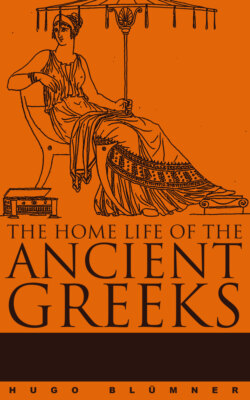Читать книгу The Home Life of the Ancient Greeks - Hugo Blumner - Страница 8
На сайте Литреса книга снята с продажи.
CHAPTER II.
BIRTH AND INFANCY
ОглавлениеTable of Contents
An Athenian Home—The Birth of a Child—Its Dedication—Its First Years—Learning to Walk—Playthings—Amusements.
We must now transport ourselves in imagination to the house of an Athenian citizen of the better classes. He is a rich man, who not only owns a comfortable, though simple, town house and land outside the gate managed by slaves, but also draws considerable interest from capital invested in trading vessels, and from the numerous slaves who work in factories for wages. But, in spite of his comfortable circumstances, his joy has hitherto been troubled by one sorrow—he has been married for several years, and as yet no heir to his possessions has been given him. A little daughter is growing up in the house to the joy of her parents, but even this cannot console the father for the sad prospect of seeing the possessions inherited from his ancestors, and increased by his own industry and economy, pass into the hands of strangers.
But to-day joy and gladness have entered this man’s house. His wife has borne him the much-longed-for son and heir. The neighbours, who had seen the well-known nurse enter the house, were anxious to see in what manner the front door would be decked—whether, as before, woollen fillets would announce the birth of a daughter, or the joyous wreath of olive branches proclaim the advent of a son and heir. While the slaves are festively decking the door
Fig. 58.
outside, within the house the new-born child is receiving its first care. With a happy smile the young mother looks on from her couch while the nurse and maids are busily occupied in preparing the bath for the little one. For this only tepid water and fine oil are used, for the Spartan custom of adding wine to the baby’s first bath is unknown at Athens. After the bath, too, the baby has a warmer bed than would have fallen to his lot in the sterner city. True, the father intends, as soon as possible, to send to Sparta for one of those celebrated nurses known and prized for their success in rearing children; but still he shrinks from beginning the hardening process at this tender age, and rearing up the child according to Spartan customs without the warm swaddling clothes. So the baby is carefully wrapped in numerous swaddlings, in such a manner that even the arms are firmly swathed, and only the little head is visible. (Compare Fig. 58.) The ancient physicians prescribe for the new-born child soft woollen swaddling three fingers broad, and direct that the swaddling should begin with the hands, then pass on to the chest, and at last cover the feet, swathing each part separately but loosely, only drawing the bandages tight at the knees and the soles of the feet; the head also must be enveloped, and, finally, a second covering is put over the whole body. When modern physicians maintain that this swaddling must injure the child and check the development of its organs, they forget that the Greeks treated their children thus for centuries and yet were a healthy nation. But it is quite incredible that they should have been thus swaddled for the first two years of their life, as a passage in Plato seems to indicate, for this would not only have been extraordinary, but also injurious to the health. It can only be a question of maintaining a covering suitable to the age for these two years, instead of the children’s dress afterwards worn. A physician of the age of the Empire recommends the end of the fourth month as the time for gradually leaving off the swaddling; and probably this was also the Greek custom. Antiquity does not seem to have been acquainted with our soft cushions, but the little Athenians also had their cradles, though these did not stand on the ground on rockers like ours, for such cradles are not mentioned till the Roman period, and seem to have been unknown in the classic age; but they resembled a basket of woven osier, suspended from ropes like a hammock, and thus made to rock. The cradle in which Hermes, who seems already to have attained the age of boyhood, is depicted on a vase painting represented in Fig. 59, is of a peculiar shape, quite like that of a shoe; the handles at the side, through which ropes were probably passed, show that this was also made to rock. Fig. 60 shows a different kind of cradle. It is a bed on rockers, which may have been used in the same way as the babies’ cots common among us.
Fig. 59.
The young mother now for the first time gives the new-born baby the breast (compare Fig. 61, taken from a Greek terra-cotta), and rejoices that she is able to perform this duty herself. However, in case she should not have been able to do it, a poor peasant woman from the neighbourhood had been brought to the house and paid for her services. Meantime, the husband sits down by the bed and discusses with his wife the steps which must next be taken. A question that sometimes causes a good deal of difficulty presents none on this occasion—viz., the legitimation of the child. And as the boy is strong and healthy, there cannot be a question of the barbarous custom
